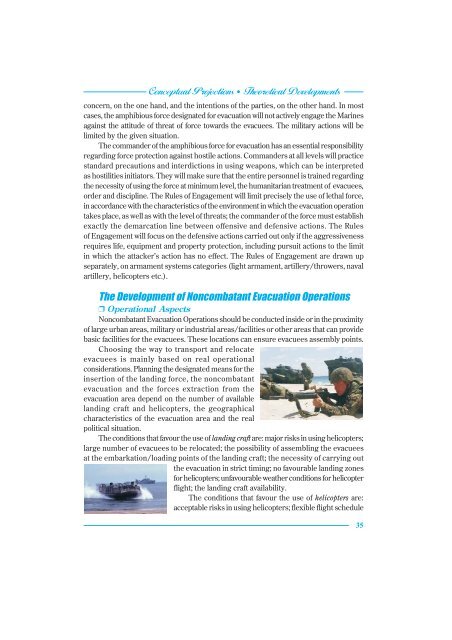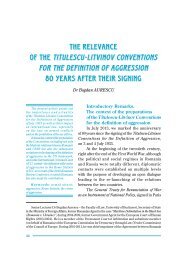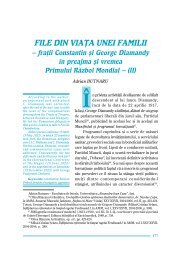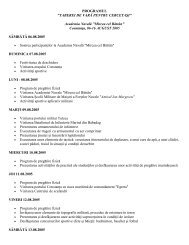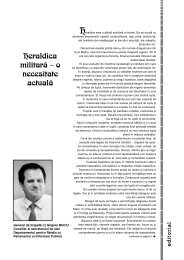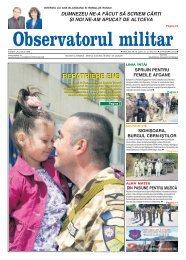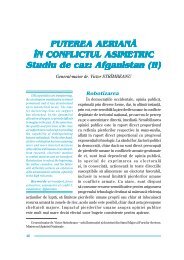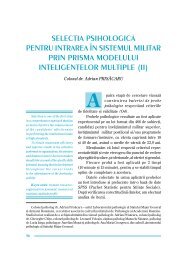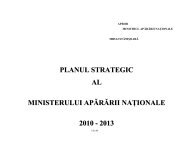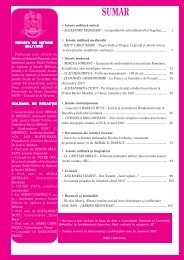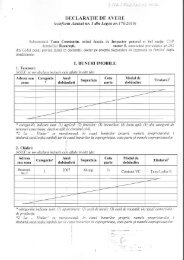Romanian Military Thinking
Romanian Military Thinking
Romanian Military Thinking
You also want an ePaper? Increase the reach of your titles
YUMPU automatically turns print PDFs into web optimized ePapers that Google loves.
Conceptual Projections • Theoretical Developments<br />
concern, on the one hand, and the intentions of the parties, on the other hand. In most<br />
cases, the amphibious force designated for evacuation will not actively engage the Marines<br />
against the attitude of threat of force towards the evacuees. The military actions will be<br />
limited by the given situation.<br />
The commander of the amphibious force for evacuation has an essential responsibility<br />
regarding force protection against hostile actions. Commanders at all levels will practice<br />
standard precautions and interdictions in using weapons, which can be interpreted<br />
as hostilities initiators. They will make sure that the entire personnel is trained regarding<br />
the necessity of using the force at minimum level, the humanitarian treatment of evacuees,<br />
order and discipline. The Rules of Engagement will limit precisely the use of lethal force,<br />
in accordance with the characteristics of the environment in which the evacuation operation<br />
takes place, as well as with the level of threats; the commander of the force must establish<br />
exactly the demarcation line between offensive and defensive actions. The Rules<br />
of Engagement will focus on the defensive actions carried out only if the aggressiveness<br />
requires life, equipment and property protection, including pursuit actions to the limit<br />
in which the attacker’s action has no effect. The Rules of Engagement are drawn up<br />
separately, on armament systems categories (light armament, artillery/throwers, naval<br />
artillery, helicopters etc.).<br />
The Development of Noncombatant Evacuation Operations<br />
Operational Aspects<br />
Noncombatant Evacuation Operations should be conducted inside or in the proximity<br />
of large urban areas, military or industrial areas/facilities or other areas that can provide<br />
basic facilities for the evacuees. These locations can ensure evacuees assembly points.<br />
Choosing the way to transport and relocate<br />
evacuees is mainly based on real operational<br />
considerations. Planning the designated means for the<br />
insertion of the landing force, the noncombatant<br />
evacuation and the forces extraction from the<br />
evacuation area depend on the number of available<br />
landing craft and helicopters, the geographical<br />
characteristics of the evacuation area and the real<br />
political situation.<br />
The conditions that favour the use of landing craft are: major risks in using helicopters;<br />
large number of evacuees to be relocated; the possibility of assembling the evacuees<br />
at the embarkation/loading points of the landing craft; the necessity of carrying out<br />
the evacuation in strict timing; no favourable landing zones<br />
for helicopters; unfavourable weather conditions for helicopter<br />
flight; the landing craft availability.<br />
The conditions that favour the use of helicopters are:<br />
acceptable risks in using helicopters; flexible flight schedule<br />
35


